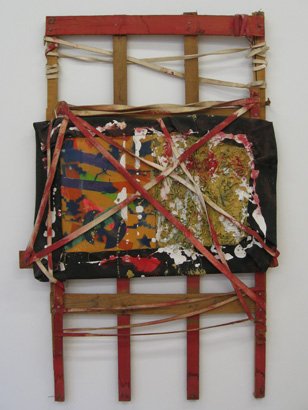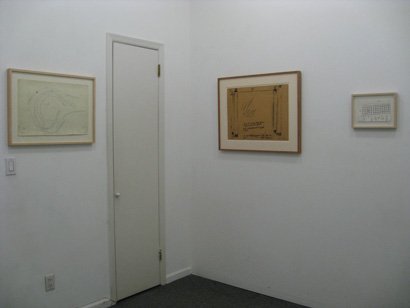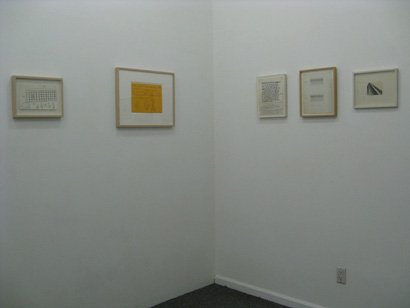STUDIO SHOW 2010
Exhibition at reedstudio is open 1-6pm on June 12, 13, 19, and at other times by appointment.
Katy Siegel and I had hoped to include Gerald Jackson’s work in an exhibition for which I was the advisor and Katy the curator, “High Times, Hard Times: New York Painting 1967-1975.” But we could not find a way to get in touch with Gerald. Then, when I was visiting the exhibition at the National Academy Museum, Gerald was there. Shortly after, he sent me a DVD of a recent performance that just astounded me. In the third Studio Show, Gerald will present this DVD with the painting included in the performance, and earlier work on skids from the ’80s.
I think that my experience growing up in America was a really black and white experience. The only color I think I really saw, that I thought was color, was on TV, commercials, or a different view of America - that America was in color and my world was in black and white.
- Gerald Jackson
In the Front Studio: Gerald Jackson
Untitled (Skid paintings) (1986-1987) and Untitled (2008-2010)
Gerald Jackson
Installation view
Untitled, 2008-2010
Household paint on canvas, DVD and clothing
Variable dimensions
Gerald Jackson
Installation view
Untitled (Skid paintings), 1987
Mixed media
65 x 42 inches
Gerald Jackson
Installation view
Untitled (Skid paintings), 1986
Mixed media
41 x 51 inches
Gerald Jackson
Installation view
Untitled (Skid paintings), ca. 1986
Mixed media
35 x 37 inches
In the Lunch Room: Michael Heizer, Richard Serra, Sol LeWitt, Donald Judd, and Lee Lozano
Drawing as “Site”/“Non–site”
curated by Peter Soriano
If words are used, and they proceed from ideas about art, then they are art and not literature; numbers are not mathematics. This small exhibition is the result of a fragment of a conversation that circles around the topic of artists reverting to means other than “drawing” when drawing, because they find words or numbers are more efficient and accurate. Mindful of the space constraints, David took pruning shears to the idea, and what resulted is a focused group of drawings made between 1965 to 1972 by New York based (more or less) artists labeled “minimalists” or “post–minimalists.” Each of the selected works addresses the issue of alternate language. Grouped this way, the artists demonstrate a radical questioning of the nature of drawing, and in particular, the nature of creating a “working drawing.” My suspicion is that the issues were raised, more than anything, by accident in discussions around issues such as process, non–hierarchical structure, and site/non–site distinction. I write “by accident” because little is mentioned with regard to what they were doing. Also, with the exception of Lee Lozano, all of these artists reverted to more traditional forms of drawing later in their careers. Chronologically, the first two are calculation drawings by Sol Lewitt and Donald Judd. Lewitt’s drawing is a calculation for an early open cube piece made in 1967 and Judd’s is the first idea for the Whitney Progression. The drawing is dated 1965 on the verso, the piece was constructed the year after. These are both almost ephemeral sheets: casual, almost destined for their real use in effectuating the piece and eventually being discarded. Yet they are both signed, changing greatly their status and therefore beginning an afterlife as works of art. Equally significant is the fact that these works are not just measurements for constructions but are entire calculations. The mathematics is the subject of the drawing in so much that the calculations are fundamental to the shape of the piece. The process of calculating, or math making, becomes art making. To some extent, these calculations also have a performance aspect, as this action of calculating is clearly located on these humble sheets. How is the act of calculating more performance than an actual drawing? I think there is a nuanced difference because the making of a drawing, with the exception of Chinese calligraphy, has no implication of time. One can take years or two minutes to complete a drawn cube. One doesn’t take years to complete a relatively simple division. Lastly, I am venturing to say that these small drawings usher in a broader definition of drawing, one that can be both a sheet of calculations and have at its core deceptively simple time–based action. For these reasons, I find that a sheet of paper seen this way becomes a “site” for something art–related with far broader boundaries than traditionally ascribed to “drawing.” The following two works expand the notion of site. Heizer’s drawing clearly implies an earth project of immense proportions. Serra’s is filled with ambiguity. It is a signed drawing that outlines the installation of a piece yet it emphatically denies its role as a drawing. Then what is it — a sheet of paper or a site where the depiction of the shapes meet the instructions? The last two drawings, by Lee Lozano, branch off into the language–based direction drawings took after the mid–1960s. The earlier of the two, “That’s It for Bumps and Waves,” is a study for the final paintings of her curve cycle now at the Wadsworth Atheneum in Hartford. The second, titled “Fish’in’the’Tank,” belongs to her language–based pieces. Together they capture some of the richness of Lozano’s use of conceptual ideas and sardonic humor. Lozano, being one of the pioneers of conceptual language–based pieces, transforms the page into a site based both in the mind and outlining a future action. — Peter Soriano, June 2010 Sol LeWitt, “Sentences on Conceptual Art,” 0–9, no. 5 (January 1969): 3–5. Reprinted in Conceptual Art: A Critical Anthology, ed. Alexander Alberro and Blake Stimson, ed. 106–108 (Cambridge, MA: MIT Press, 2000). |
||
Installation Views
Checklist:
Michael Heizer
Untitled, 1971
Pencil on paper
14-5/8 x 7/8 inches
Richard Serra
Untitled (Drawing for Sculpture for Moderna Museet, Stockholm), 1972
Charcoal and graphite on paper
18 x 24 inches
Sol LeWitt
Untitled, 1967
Black ink on paper
6 x 9-9/16 inches
Donald Judd
Untitled (Study for Whitney Progression), 1965
Ink on paper
8-5/8 x 10-15/16 inches
Lee Lozano
Untitled (Fish-in-the-Tank-Piece), 1969
Ink on graph paper
11 x 9 inches
Lee Lozano
That's It for Bumps and Waves, 1968
Pencil on paper
8-7/8 x 10-7/8
Lee Lozano
Untitled, ca. 1965
Pencil on paper
3-1/4 x 4 inches
In the Office: Nancy Arlen, Lillian Ball, Bill Bollinger, Judy Pfaff, and Alan Shields
curated by Rey Akdogan
Checklist:
Lillian Ball
In the Loop, 1994
Resin, bronze and vinyl
20-1/2 x 12 inches
Alan Shields
Untitled, ca. 1975
Wood, bamboo, tissue paper, leather and copper wire
28 x 22 x 24 inches
Bill Bollinger
Untitled, ca. 1970s
Prefabricated aluminum
59 inches
Bill Bollinger
Drawing for Sculpture, ca. 1970s
Pencil on paper
8-1/8 x 11-5/8 inches
Judy Pfaff
Untitled, ca. 1970s
Pipe-cleaners
Size variable
Judy Pfaff
Untitled, ca. 1970s
Electrical wire
Size variable
Judy Pfaff
Brushmarks, ca. 1970s
Electrical wire (4 parts)
Size variable
Nancy Arlen
Untitled, 1979
Cast polyester resin, mounting hardware
2 x 18 x 28 inches
Lee Lozano
General Strike Piece, 1969
Mimeograph
11 x 8-1/2 inches













